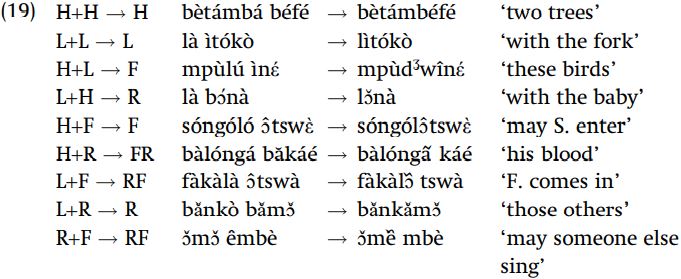


 Grammar
Grammar
 Tenses
Tenses
 Present
Present
 Past
Past
 Future
Future
 Parts Of Speech
Parts Of Speech
 Nouns
Nouns
 Verbs
Verbs
 Adverbs
Adverbs
 Adjectives
Adjectives
 Pronouns
Pronouns
 Pre Position
Pre Position
 Preposition by function
Preposition by function 
 Preposition by construction
Preposition by construction
 Conjunctions
Conjunctions
 Interjections
Interjections
 Grammar Rules
Grammar Rules
 Linguistics
Linguistics
 Semantics
Semantics
 Pragmatics
Pragmatics
 Reading Comprehension
Reading Comprehension|
Read More
Date: 2023-12-05
Date: 9-4-2022
Date: 2024-03-28
|
One very common property exhibited by tones is stability, where the deletion of a vowel does not result in the deletion of the tone borne by the vowel. Very commonly the tone of a deleted vowel is transferred to the neighboring vowel, often resulting in a contour tone. We have seen an example of this phenomenon in Yekhee, where the combination of an L vowel plus H vowel results in a rising-toned vowel, and H+L gives a falling-toned vowel.

In the autosegmental theory, deletion of a vowel does not directly affect the tone which was associated with it, and as a result, after deletion of the vowel the tone simply remains on the tonal tier with no association with the segmental tier – such an unassociated tone is referred to as a floating tone.

One of the principles proposed in this theory is that all vowels must (eventually) bear some tone, and all tones must be borne by some vowel – this condition is known as the Well-formedness Condition. Accordingly the unassociated tones which resulted from the deletion of a vowel would then be associated with the following vowel, resulting in a falling or rising tone.

The combination of two like-toned vowels, as in the case of èké élà ! èkélà ‘three rams,’ brings out another principle of the theory. By the operation of vowel deletion and reassociation of the floating tone, one would expect the following representation.

This would not be distinct from the simple tone melody LHL: (17) says that the vowel e should be produced at high pitch at the beginning and at the end, with no other pitches being produced. The Twin Sister Convention was proposed as a constraint on the theory, so that such a phonetically indistinguishable representation is formally disallowed.

Another illustration of the autosegmental treatment of tone preservation comes from Mongo. When vowels are brought together, either directly in the underlying representation or as the result of deleting certain consonants, the vowel sequence is reduced to a single vowel which preserves all of the component tones of the two vowels. This can result not just in the simple contours R and F, but also in the complex three-tone contours fall–rise (FR) and rise–fall (RF).

The derivation of the last example illustrates how the autosegmental theory explains the pattern elegantly. In this case, the first vowel deletes, causing its two tones to become floating. Those tones are associated with the following vowel by the Well-formedness Conditions. This results in two adjacent H tones on one vowel, which by the Twin Sister Convention reduce to one H, giving the phonetic output.

The fact that the theory effortlessly handles three-tone contours, when the linear theory struggled to handle even two-tone contours, is clear evidence that autosegmental theory is the better theory.
|
|
|
|
دخلت غرفة فنسيت ماذا تريد من داخلها.. خبير يفسر الحالة
|
|
|
|
|
|
|
ثورة طبية.. ابتكار أصغر جهاز لتنظيم ضربات القلب في العالم
|
|
|
|
|
|
|
سماحة السيد الصافي يؤكد ضرورة تعريف المجتمعات بأهمية مبادئ أهل البيت (عليهم السلام) في إيجاد حلول للمشاكل الاجتماعية
|
|
|